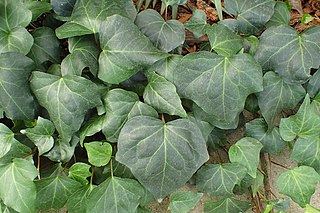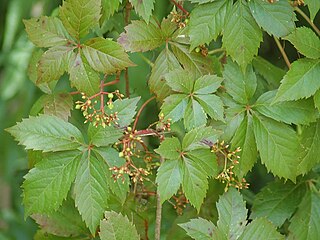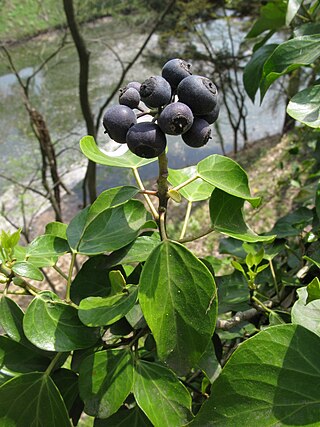
The Araliaceae are a family of flowering plants composed of about 43 genera and around 1500 species consisting of primarily woody plants and some herbaceous plants. The morphology of Araliaceae varies widely, but it is predominantly distinguishable based on its woody habit, tropical distribution, and the presence of simple umbels.

Hedera, commonly called ivy, is a genus of 12–15 species of evergreen climbing or ground-creeping woody plants in the family Araliaceae, native to western, central and southern Europe, Macaronesia, northwestern Africa and across central-southern Asia east to Japan and Taiwan.

Parthenocissus quinquefolia, known as Virginia creeper, Victoria creeper, five-leaved ivy, or five-finger, is a species of flowering vine in the grape family, Vitaceae. It is native to eastern and central North America, from southeastern Canada and the eastern United States west to Manitoba and Utah, and south to eastern Mexico and Guatemala.

Hedera hibernica, common name Atlantic ivy, Boston Ivy or Irish ivy, is a woody vine native to the Atlantic coast of Europe.

Hedera helix, the common ivy, English ivy, European ivy, or just ivy, is a species of flowering plant of the ivy genus in the family Araliaceae, native to most of Europe and western Asia. A rampant, clinging evergreen vine, it is a familiar sight in gardens, waste spaces, and wild areas, where it grows on walls, fences, tree trunks, etc. across its native and introduced habitats. As a result of its hardy nature, and its tendency to grow readily without human assistance, ivy attained popularity as an ornamental plant, but escaped plants have become naturalised outside its native range and grow unchecked in myriad wild and cultivated areas.

× Fatshedera is hybrid genus of flowering plants, common name tree ivy or aralia ivy. It has only one species, × Fatshedera lizei. The hybrid symbol × in front of the name indicates that this is an inter-generic hybrid, a cross between plants from different genera. The name may be displayed with or without a space after the × symbol.

State Reserves of Azerbaijan refers to the state reserves in Azerbaijan, which preserve the fauna, flora and their ecosystems.

Hirkan National Park — is a national park of Azerbaijan. It was established in an area in Lankaran Rayon and Astara Rayon administrative districts on February 9, 2004 on the basis of the former "Hirkan State Reserve" which it superseded, on a surface area of 29,760 hectares (297.6 km2). It was enlarged by presidential decree on April 23, 2008 from 29,760 hectares (297.6 km2) to 40,358 hectares (403.58 km2).

Zagatala State Nature Reserve - is a reserve in the Zagatala and Balakan districts of Azerbaijan. It was established in 1929 in the middle part of the southern foothills of the Greater Caucasus Mountains in the territory of Zagatala and Balakan districts on an area of 25200 hectares. It is located on the eastern slope of the Greater Caucasus Range in Azerbaijan. Zagatala Reserve was established in 1930-0 as a separate reserve together with the Balakan Reserve. The height of the reserve varies from 650 to 3646 m above sea level. The flora of the base of the reserve consists of mountain forests and mountain meadows. More than a thousand species of modern flora are observed here. [2] The territory of the reserve has changed many times and now stands at 28,844 hectares. There are more than 900 plant species in the reserve, which is 1/6 of the flora of Azerbaijan. More than 60% of the reserve area consists of broadleaf forests. The main purpose of the reserve is to protect the natural complexes of rare plants on the southern slopes of the Greater Caucasus Mountains.

Schefflera taiwaniana (台湾鹅掌柴) is a species of flowering plant in the family Araliaceae, native to Taiwan, where it is scattered throughout coniferous forests at 2,000–3,000 m (6,600–9,800 ft). Growing to 4 m (13 ft) tall by 2.5 m (8.2 ft) broad, it is an evergreen shrub or small tree. Large leaves up to 15 cm (5.9 in) long are composed of up to 11 ovate leaflets arranged radially around a central stalk. Young leaves are covered in silver hairs, while mature leaves have a smooth surface. Sprays of flowers in late summer are followed by dark berries in winter - a valued food source for insects and birds.

Hedera nepalensis is a species of perennial Ivy native to Nepal and Bhutan, as well as Afghanistan, Pakistan, India, China, Laos, Myanmar, Thailand, and Vietnam, at altitudes of about 1000–3000 m. Plants grow up to 30 m in height, with simple leaves ranging from 2–15 cm long, and yellow flowers.

Hedera canariensis, the Canary Island ivy, Canary ivy or Madeira ivy, is a species of ivy, native to the Canary Islands and possibly the Atlantic coast of northern Africa.
Hedera maderensis, the Madeiran ivy, is a species of ivy which is native to the Atlantic coast in Madeira island. It is a plant of botanical family Araliaceae, species endemic to the island of Madeira with the name: Hedera maderensis. Formerly a subspecies named Hedera maderensis iberica, one iberian subspecies in west Iberian peninsula was subsequently classified as a distinct species. It is quite common in Madeira and lives in slopes rock, soil, trunks of trees especially in Laurel forest of Barbusano.

Hedera maroccana, the Moroccan ivy, is a species of ivy which is native to the Atlantic coast in northern Africa. It is an evergreen climbing plant, growing to 20–30 m high where suitable surfaces are available, and also growing as ground cover where there are no vertical surfaces. It climbs by means of aerial rootlets which cling to the substrate. In warm climates, it grows more rapidly and becomes established a good bit faster than the related Hedera hibernica and Hedera helix.

Hedera colchica is a species of ivy which is native to Near and Middle East. It is commonly called Persian ivy or colchis ivy. It is an evergreen climbing plant, growing to 30 m high where suitable surfaces are available, and also growing as ground cover where there are no vertical surfaces. It climbs by means of aerial rootlets which cling to the substrate. In warm climates, it grows more rapidly and becomes established faster than other Hedera species.

Hedera iberica is a species of ivy which is native to the western Iberian peninsula, and northern Morocco. It was formerly classified as a sub-species named Hedera maderensis iberica in Hedera maderensis. The Iberian subspecies was subsequently classified as a distinct species. It grows on slopes, rock, soil, trunks of trees.

Hedera azorica, the Azores ivy, is a species of ivy which is native to the Atlantic coast in the Azores Islands. It is an evergreen climbing plant, growing to 20–30 m high where suitable surfaces are available, and grows as ground cover where there are no vertical surfaces. It climbs by means of aerial rootlets which cling to the substrate.
Hedera cypria, is a species of Ivy which is endemic to the island of Cyprus. It is an evergreen climbing plant, growing slowly to 20–30 m high where suitable surfaces are available, and also growing as ground cover where there are no vertical surfaces. It climbs by means of aerial rootlets which cling to the substrate. It is more common at higher altitudes in rocky, shadowy riverine forest, over 400–650 m. In its natural habitat it can be distinguished easily from Hedera helix subsp. poetarum, also present, because the latter has yellow fruits, while Hedera cypria is always black-fruited.

Hedera rhombea, the Japanese ivy or songak, is a species of ivy in the Araliaceae family native to East Asia. Formerly named Hedera pedunculata, some subspecies could be subsequently classified as a distinct species. It is common on rocky slopes and growing up the trunks of trees, especially in laurel forest, a type of cloud forest.

Shaki-Zagatala Economic Region is one of the 14 economic regions of Azerbaijan. It borders Russia to the north and Georgia to the west, as well as the economic regions of Quba-Khachmaz, Mountainous Shirvan, Central Aran, and Ganja-Dashkasan. The region consists of the districts of Balakan, Zagatala, Gakh, Shaki, Oghuz and Qabala. It has an area of 8,840 square kilometres (3,410 sq mi). Its population was estimated to be at 630.4 thousand people in January 2021.


















